
wanwu
China Unicom's Yuanjing Wanwu Agent Platform is an enterprise-grade, multi-tenant AI agent development platform. It helps users build applications such as intelligent agents, workflows, and rag, and also supports model management. The platform features a developer-friendly license, and we welcome all developers to build upon the platform.
Stars: 1398
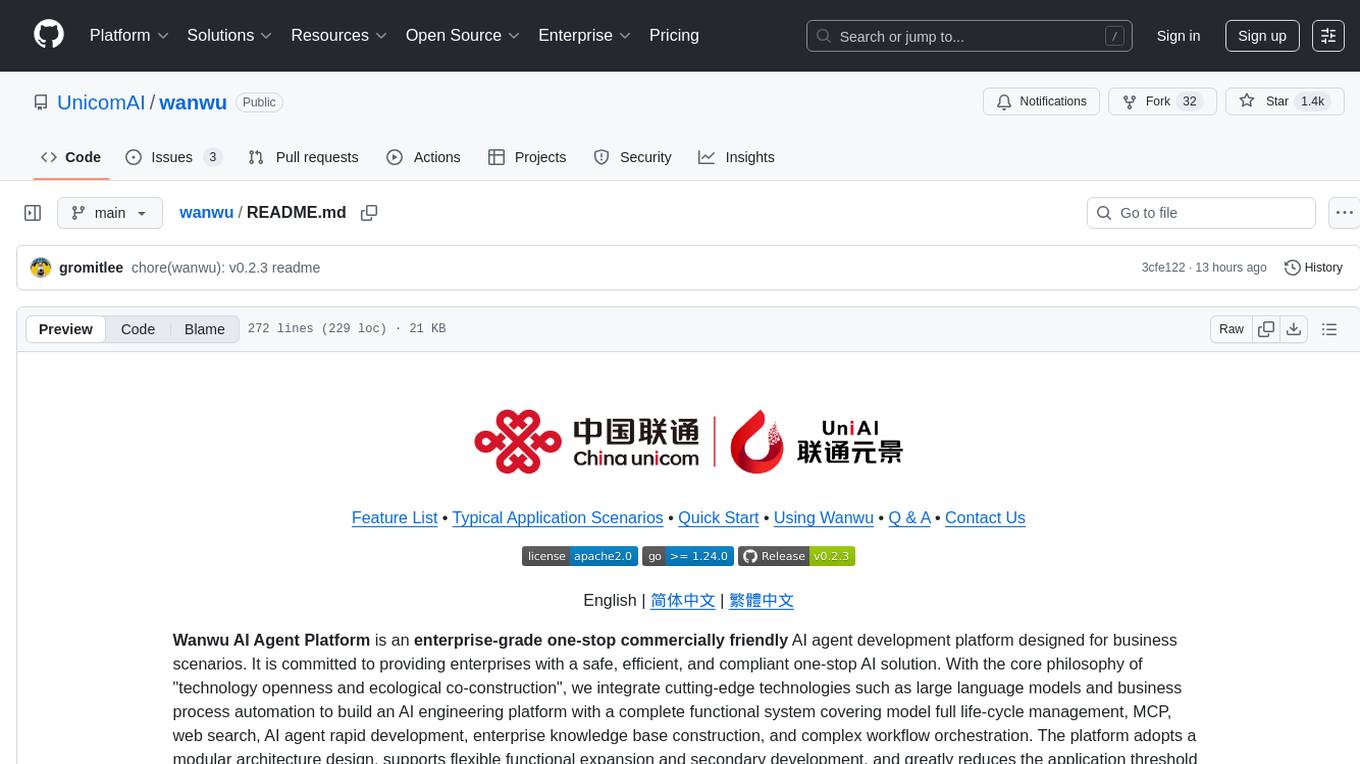
Wanwu AI Agent Platform is an enterprise-grade one-stop commercially friendly AI agent development platform designed for business scenarios. It provides enterprises with a safe, efficient, and compliant one-stop AI solution. The platform integrates cutting-edge technologies such as large language models and business process automation to build an AI engineering platform covering model full life-cycle management, MCP, web search, AI agent rapid development, enterprise knowledge base construction, and complex workflow orchestration. It supports modular architecture design, flexible functional expansion, and secondary development, reducing the application threshold of AI technology while ensuring security and privacy protection of enterprise data. It accelerates digital transformation, cost reduction, efficiency improvement, and business innovation for enterprises of all sizes.
README:
Wanwu AI Agent Platform is an enterprise-grade one-stop commercially friendly AI agent development platform designed for business scenarios. It is committed to providing enterprises with a safe, efficient, and compliant one-stop AI solution. With the core philosophy of "technology openness and ecological co-construction", we integrate cutting-edge technologies such as large language models and business process automation to build an AI engineering platform with a complete functional system covering model full life-cycle management, MCP, web search, AI agent rapid development, enterprise knowledge base construction, and complex workflow orchestration. The platform adopts a modular architecture design, supports flexible functional expansion and secondary development, and greatly reduces the application threshold of AI technology while ensuring the security and privacy protection of enterprise data. Whether it is for small and medium-sized enterprises to quickly build intelligent applications or for large enterprises to achieve intelligent transformation of complex business scenarios, the Wanwu AI Agent Platform can provide strong technical support to help enterprises accelerate the process of digital transformation, achieve cost reduction and efficiency improvement, and business innovation.
🔥 Adopt a permissive and friendly Apache 2.0 License, supporting developers to freely expand and develop secondary
✔ Enterprise-level engineering: Provides a complete toolchain from model management to application landing, solving the "last mile" problem of LLM technology landing
✔ Open-source ecological: Adopt a permissive and friendly Apache 2.0 License, supporting developers to freely expand and develop
✔ Full-stack technology support: Equipped with a professional team to provide architecture consulting, performance optimization and full-cycle empowerment for ecological partners
✔ Multi-tenant architecture: Provides a multi-tenant account system to meet the core needs of users in cost control, data security isolation, business elasticity expansion, industry customization, rapid online and ecological collaboration
✔ XinChuang adaptation: Already adapted to domestic XinChuang databases TiDB and OceanBase
1. Model Management (Model Hub) ▸ Supports the unified access and lifecycle management of hundreds of proprietary/open-source large models (including GPT, Claude, Llama, etc.)
▸ Deeply adapts to OpenAI API standards and Unicom Yuanjing ecological models, realizing seamless switching of heterogeneous models
▸ Provides multi-inference backend support (vLLM, TGI, etc.) and self-hosted solutions to meet the computing power needs of enterprises of different scales
▸ Standardized interfaces: Enable AI models to seamlessly connect to various external tools (such as GitHub, Slack, databases, etc.) without the need to develop adapters for each data source separately
▸ Built-in rich and selected recommendations: Integrates 100+ industry MCP interfaces, making it easy for users to call up quickly and easily
▸ Real-time information acquisition: Possesses powerful web search capabilities, capable of obtaining the latest information from the Internet in real-time. In question and answer scenarios, when a user's question requires the latest news, data, and other information, the platform can quickly search and return accurate results, enhancing the timeliness and accuracy of the answers
▸ Multi-source data integration: Integrates various Internet data sources, including news websites, academic databases, industry reports, etc. Through the integration and analysis of multi-source data, it provides users with more comprehensive and in-depth information. For example, in market research scenarios, relevant data can be obtained from multiple data sources at the same time for comprehensive analysis and evaluation
▸ Intelligent search strategy: Adopt intelligent search algorithms, automatically optimize search strategies based on user questions to improve search efficiency and accuracy. Support keyword search, semantic search and other search methods to meet the needs of different users. At the same time, intelligently sort and filter search results, prioritize the display of the most relevant and valuable information
▸ Quickly build complex AI business processes through low-code drag-and-drop canvas
▸ Built-in conditional branching, API, large model, knowledge base, code, MCP and other nodes, support end-to-end process debugging and performance analysis
▸ Provides the whole process knowledge management capabilities of knowledge base creation → document parsing → vectorization → retrieval → fine sorting, supports multiple formats such as pdf/docx/txt/xlsx/csv/pptx documents, and also supports the capture and access of web resources
▸ Integrates multi-modal retrieval, cascading segmentation and adaptive segmentation, significantly improves the accuracy of Q&A
▸ Can be based on the function call (Function Calling) agent construction paradigm, supports tool expansion, private knowledge base association and multi-round dialogue
▸ Support online debugging
▸ Provides RESTful API, supports deep integration with existing enterprise systems (OA/CRM/ERP, etc.)
▸ Provides fine-grained permission control to ensure stable operation in production environments
| Function | Wanwu | Dify.AI | Fastgpt | Ragflow | Coze open source version |
|---|---|---|---|---|---|
| Model import | ✅ | ✅ | ❌(Built-in models) | ✅ | ❌(Built-in models) |
| RAG engine | ✅ | ✅ | ✅ | ✅ | ✅ |
| MCP | ✅ | ✅ | ✅ | ✅(Need to install tools to use) | ❌ |
| Direct OCR import | ✅ | ❌ | ❌ | ❌ | ❌ |
| Search enhancement | ✅ | ✅(Need to install tools to use) | ✅ | ✅(Need to install tools to use) | ✅ |
| Agent | ✅ | ✅ | ✅ | ✅ | ✅ |
| Workflow | ✅ | ✅ | ✅ | ✅ | ✅ |
| Local deployment | ✅ | ✅ | ✅ | ✅ | ✅ |
| license friendly | ✅ | ❌(Commercially restricted) | ❌(Commercially restricted) | Not fully open source | ✅ |
| Multi-tenant | ✅ | ❌(Commercially restricted) | ❌(Commercially restricted) | ✅ | ✅(Users are not interconnected) |
As of August 1, 2025.
- Intelligent Customer Service: Realize high-accuracy business consultation and ticket processing based on RAG + Agent
- Knowledge Management: Build an exclusive enterprise knowledge base, support semantic search and intelligent summary generation
- Process Automation: Realize AI-assisted decision-making for business processes such as contract review and reimbursement approval through the workflow engine The platform has been successfully applied in multiple industries such as finance, industry, and government, helping enterprises transform the theoretical value of LLM technology into actual business benefits. We sincerely invite developers to join the open source community and jointly promote the democratization of AI technology.
- The workflow module of the Wanwu AI Agent Platform uses the following project, you can go to its warehouse to view the details.
- v0.1.8 and earlier: wanwu-agentscope project
- v0.2.0 and later: wanwu-workflow project
- Docker Installation (Recommended)
-
Before the first run
1.1 Copy the environment variable file
cp .env.bak .env
1.2 Modify the
WANWU_ARCHandWANWU_EXTERNAL_IPvariables in the.envfile according to the system# amd64 / arm64 WANWU_ARCH=amd64 # external ip port (Note: if the browser accesses Wanwu deployed on a non-localhost server, you need to change localhost to the external IP, for example, 192.168.xx.xx) WANWU_EXTERNAL_IP=localhost1.3 Create a Docker running network
docker network create wanwu-net -
Start the service (the image will be automatically pulled from Docker Hub during the first run)
# For amd64 system: docker compose --env-file .env --env-file .env.image.amd64 up -d # For arm64 system: docker compose --env-file .env --env-file .env.image.arm64 up -d
-
Log in to the system: http://localhost:8081
Default user: admin Default password: Wanwu123456 -
Stop the service
# For amd64 system: docker compose --env-file .env --env-file .env.image.amd64 down # For arm64 system: docker compose --env-file .env --env-file .env.image.arm64 down
- Source Code Start (Development)
- Based on the above Docker installation steps, start the system service completely
- Take the backend bff-service service as an example
2.1 Stop bff-service
2.2 Compile the bff-service executable filemake -f Makefile.develop stop-bff
2.3 Start bff-service# For amd64 system: make build-bff-amd64 # For arm64 system: make build-bff-arm64make -f Makefile.develop run-bff
- Based on the above Docker installation steps, completely stop the system service
- Update to the latest version of the code
2.1 In the wanwu repository directory, update the code
2.2 Recopy the environment variable file (if there are changes to the environment variables, please modify them again)
# Switch to the main branch git checkout main # Pull the latest code git pull
# Backup the current .env file cp .env .env.old # Copy the .env file cp .env.bak .env
- Based on the above Docker installation steps, completely start the system service
To help you quickly get started with this project, we strongly recommend that you first check out the Documentation Operation Manual. We provide users with interactive and structured operation guides, where you can directly view operation instructions, interface documents, etc., greatly reducing the threshold for learning and use. The detailed function list is as follows:
| Feature | Detailed Description |
|---|---|
| Model Management | Supports users to import LLM, Embedding, and Rerank models from various model providers, including Unicom Yuanjing, OpenAI-API-compatible, Ollama, Tongyi Qianwen, and Volcano Engine. Model Import Methods - Detailed Version |
| Knowledge Base | In terms of document parsing capabilities: supports uploading of 12 file types and URL parsing; document parsing methods include OCR and high-precision model parsing (titles/tables/formulas); document segmentation settings support both general segmentation and parent-child segmentation. In terms of optimization capabilities: supports metadata management and metadata filtering queries, supports adding, deleting, and modifying segmented content, supports setting keyword tags for segments to improve recall performance, supports segment enable/disable operations, and supports hit testing. In terms of retrieval capabilities: supports multiple retrieval modes including vector search, full-text search, and hybrid search. In terms of Q&A capabilities: supports automatic citation of sources and generating answers with both text and images.<br |
| Resource Library | Supports importing your own MCP services or custom tools for use in workflows and agents. |
| Safety Guardrails | Users can create sensitive word lists to control the safety of the model's output. |
| Text Q&A | A dedicated knowledge advisor based on a private knowledge base. It supports features like knowledge base management, Q&A, knowledge summarization, personalized parameter configuration, safety guardrails, and retrieval configuration to improve the efficiency of knowledge management and learning. Supports publishing text Q&A applications publicly or privately, and can be published as an API. |
| Workflow | Extends the capabilities of agents. Composed of nodes, it provides a visual workflow editor. Users can orchestrate multiple different workflow nodes to implement complex and stable business processes. Supports publishing workflow applications publicly or privately, can be published as an API, and supports import/export. |
| Agent | Create agents based on user scenarios and business requirements. Supports model selection, prompt setting, web search, knowledge base selection, MCP, workflows, and custom tools. Supports publishing agent applications publicly or privately, and can be published as an API and a Web URL. |
| App Marketplace | Allows users to experience published applications, including Text Q&A, Workflows, and Agents. |
| MCP Hub | Features 100+ pre-selected industry-specific MCP servers, ready for immediate use. |
| Settings | The platform supports multi-tenancy, allowing users to manage organizations, roles, users, and perform basic platform configuration. |
- [ ] Multi-modal model access
- [ ] Support custom MCP Server, which means that workflows, agents, or APIs that conform to the OpenAPI specification can be added to the MCP Server for release
- [ ] Knowledge base sharing
- [ ] Agent and model evaluation
- [ ] Agent monitoring statistics
- [ ] Model experience
- [ ] Prompt engineering
-
[Q] Error when starting Elastic (elastic-wanwu) on Linux system: Memory limited without swap. [A] Stop the service, run
sudo sysctl -w vm.max_map_count=262144, and then restart the service. -
[Q] After the system services start normally, the mysql-wanwu-setup and elastic-wanwu-setup containers exit with status code Exited (0). [A] This is normal. These two containers are used to complete some initialization tasks and will automatically exit after execution.
-
[Q] Regarding model import [A] Taking the import of Unicom Yuanjing LLM as an example (the process is similar for importing OpenAI-API-compatible models, Embedding, or Rerank types):
1. The Open API interface for Unicom Yuanjing MaaS Cloud LLM is, for example: https://maas.ai-yuanjing.com/openapi/compatible-mode/v1/chat/completions 2. The API Key applied for by the user on Unicom Yuanjing MaaS Cloud looks like: sk-abc********************xyz 3. Confirm that the API and Key can correctly request the LLM. Taking a request to yuanjing-70b-chat as an example: curl --location 'https://maas.ai-yuanjing.com/openapi/compatible-mode/v1/chat/completions' \ --header 'Content-Type: application/json' \ --header 'Accept: application/json' \ --header 'Authorization: Bearer sk-abc********************xyz' \ --data '{ "model": "yuanjing-70b-chat", "messages": [{ "role": "user", "content": "你好" }] }' 4. Import the model: 4.1 [Model Name] must be the model that can be correctly requested in the curl command above; for example, yuanjing-70b-chat. 4.2 [API Key] must be the key that can be correctly requested in the curl command above; for example, sk-abc********************xyz (note: do not include the 'Bearer' prefix). 4.3 [Inference URL] must be the URL that can be correctly requested in the curl command above; for example, https://maas.ai-yuanjing.com/openapi/compatible-mode/v1 (note: do not include the /chat/completions suffix). 5. Importing an Embedding model is the same as importing an LLM as described above. Note that the inference URL should not include the /embeddings suffix. 6. Importing a Rerank model is the same as importing an LLM as described above. Note that the inference URL should not include the /rerank suffix.
The Yuanjing Wanwu AI Agent Platform is released under the Apache License 2.0.
| QQ Group1(Full):490071123 | QQ Group2:1026898615 |
|---|---|
For Tasks:
Click tags to check more tools for each tasksFor Jobs:
Alternative AI tools for wanwu
Similar Open Source Tools

wanwu
Wanwu AI Agent Platform is an enterprise-grade one-stop commercially friendly AI agent development platform designed for business scenarios. It provides enterprises with a safe, efficient, and compliant one-stop AI solution. The platform integrates cutting-edge technologies such as large language models and business process automation to build an AI engineering platform covering model full life-cycle management, MCP, web search, AI agent rapid development, enterprise knowledge base construction, and complex workflow orchestration. It supports modular architecture design, flexible functional expansion, and secondary development, reducing the application threshold of AI technology while ensuring security and privacy protection of enterprise data. It accelerates digital transformation, cost reduction, efficiency improvement, and business innovation for enterprises of all sizes.
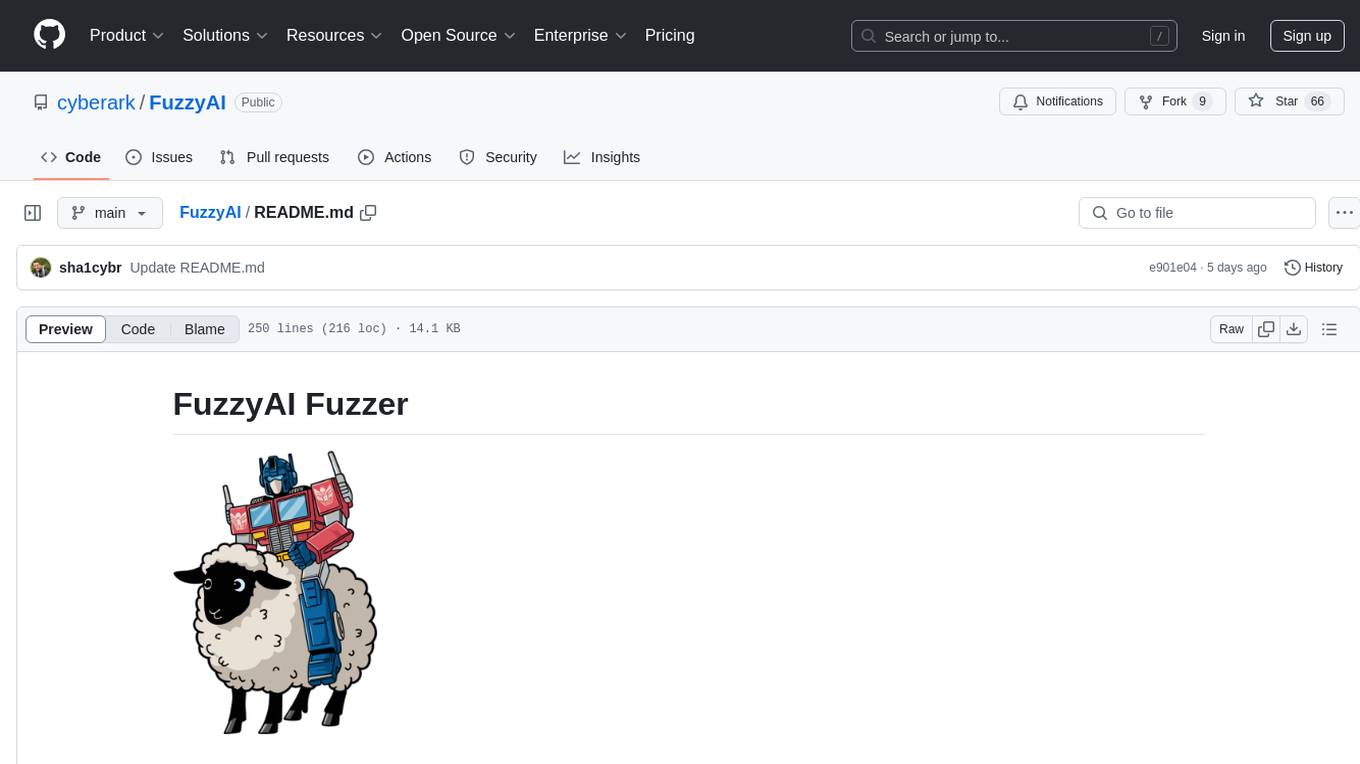
FuzzyAI
The FuzzyAI Fuzzer is a powerful tool for automated LLM fuzzing, designed to help developers and security researchers identify jailbreaks and mitigate potential security vulnerabilities in their LLM APIs. It supports various fuzzing techniques, provides input generation capabilities, can be easily integrated into existing workflows, and offers an extensible architecture for customization and extension. The tool includes attacks like ArtPrompt, Taxonomy-based paraphrasing, Many-shot jailbreaking, Genetic algorithm, Hallucinations, DAN (Do Anything Now), WordGame, Crescendo, ActorAttack, Back To The Past, Please, Thought Experiment, and Default. It supports models from providers like Anthropic, OpenAI, Gemini, Azure, Bedrock, AI21, and Ollama, with the ability to add support for newer models. The tool also supports various cloud APIs and datasets for testing and experimentation.
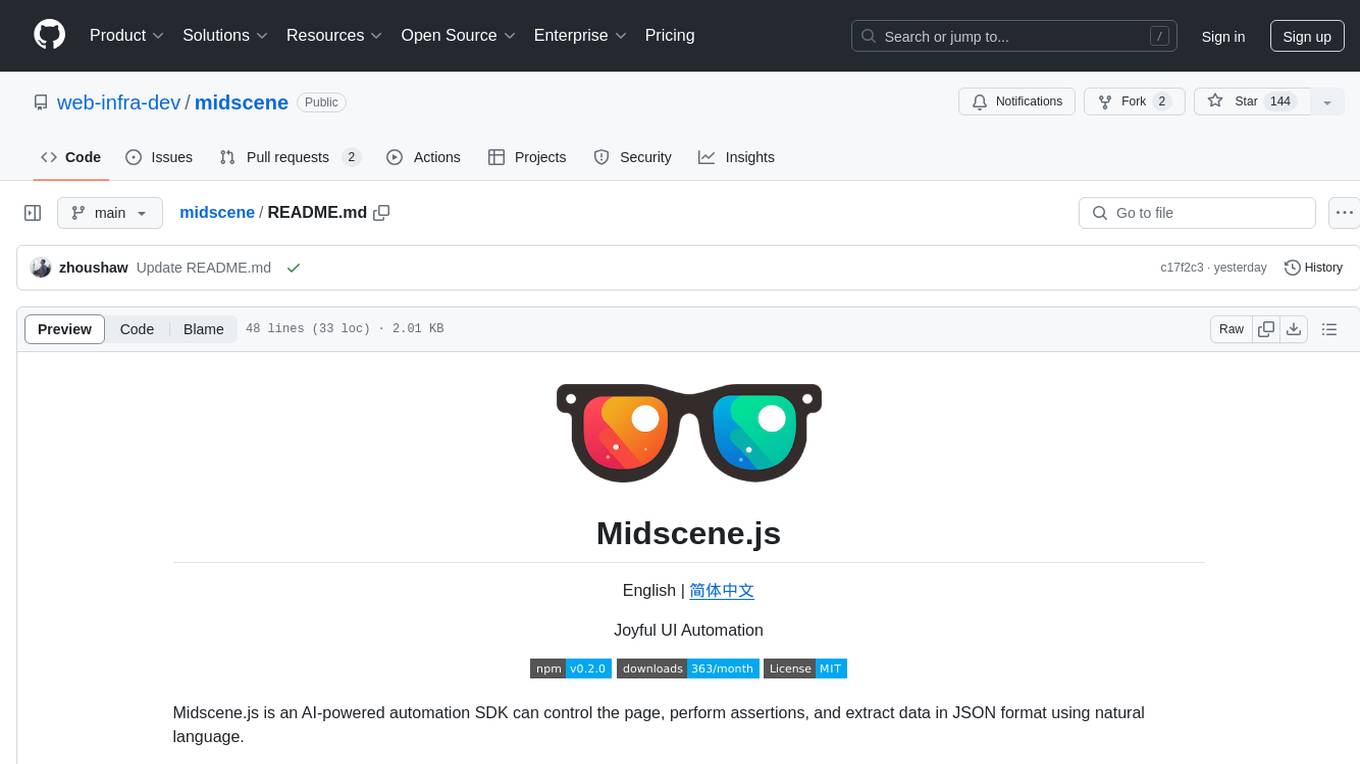
midscene
Midscene.js is an AI-powered automation SDK that allows users to control web pages, perform assertions, and extract data in JSON format using natural language. It offers features such as natural language interaction, understanding UI and providing responses in JSON, intuitive assertion based on AI understanding, compatibility with public multimodal LLMs like GPT-4o, visualization tool for easy debugging, and a brand new experience in automation development.
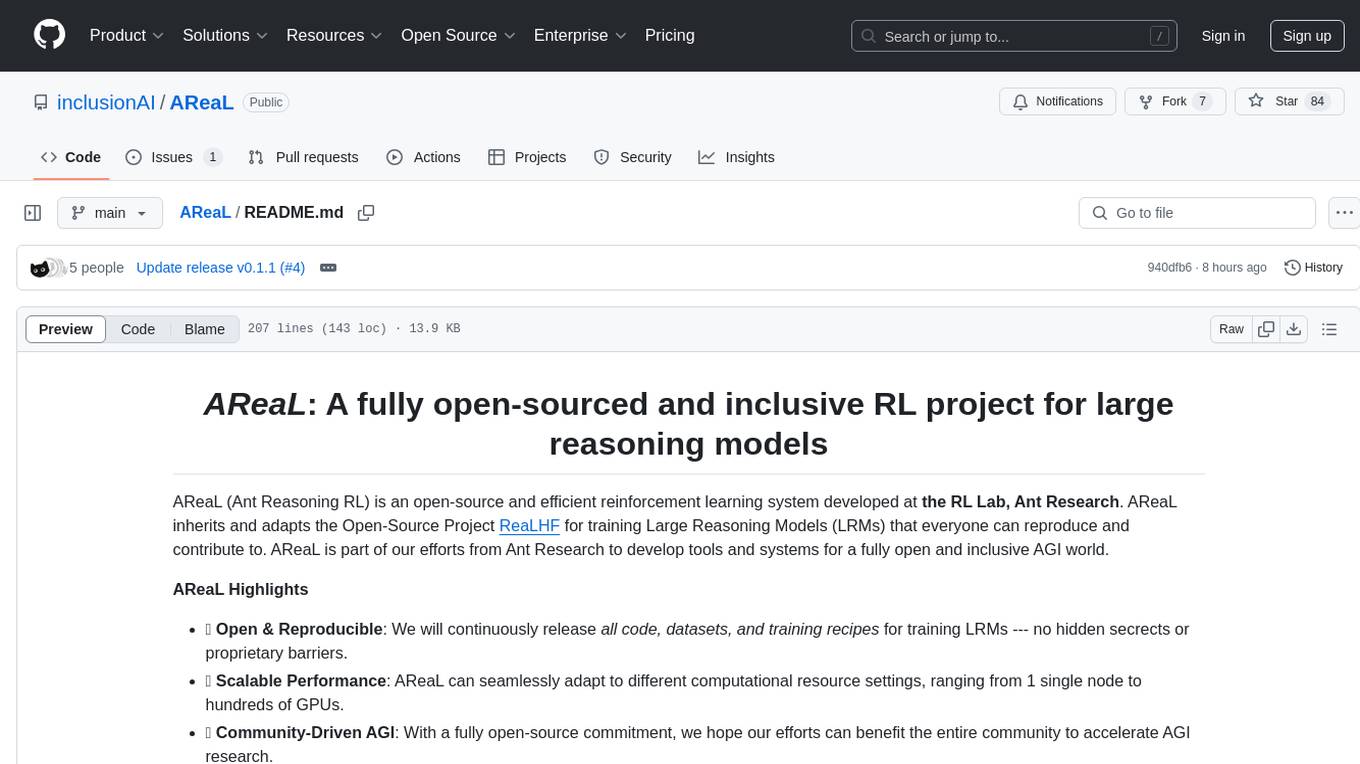
AReaL
AReaL (Ant Reasoning RL) is an open-source reinforcement learning system developed at the RL Lab, Ant Research. It is designed for training Large Reasoning Models (LRMs) in a fully open and inclusive manner. AReaL provides reproducible experiments for 1.5B and 7B LRMs, showcasing its scalability and performance across diverse computational budgets. The system follows an iterative training process to enhance model performance, with a focus on mathematical reasoning tasks. AReaL is equipped to adapt to different computational resource settings, enabling users to easily configure and launch training trials. Future plans include support for advanced models, optimizations for distributed training, and exploring research topics to enhance LRMs' reasoning capabilities.
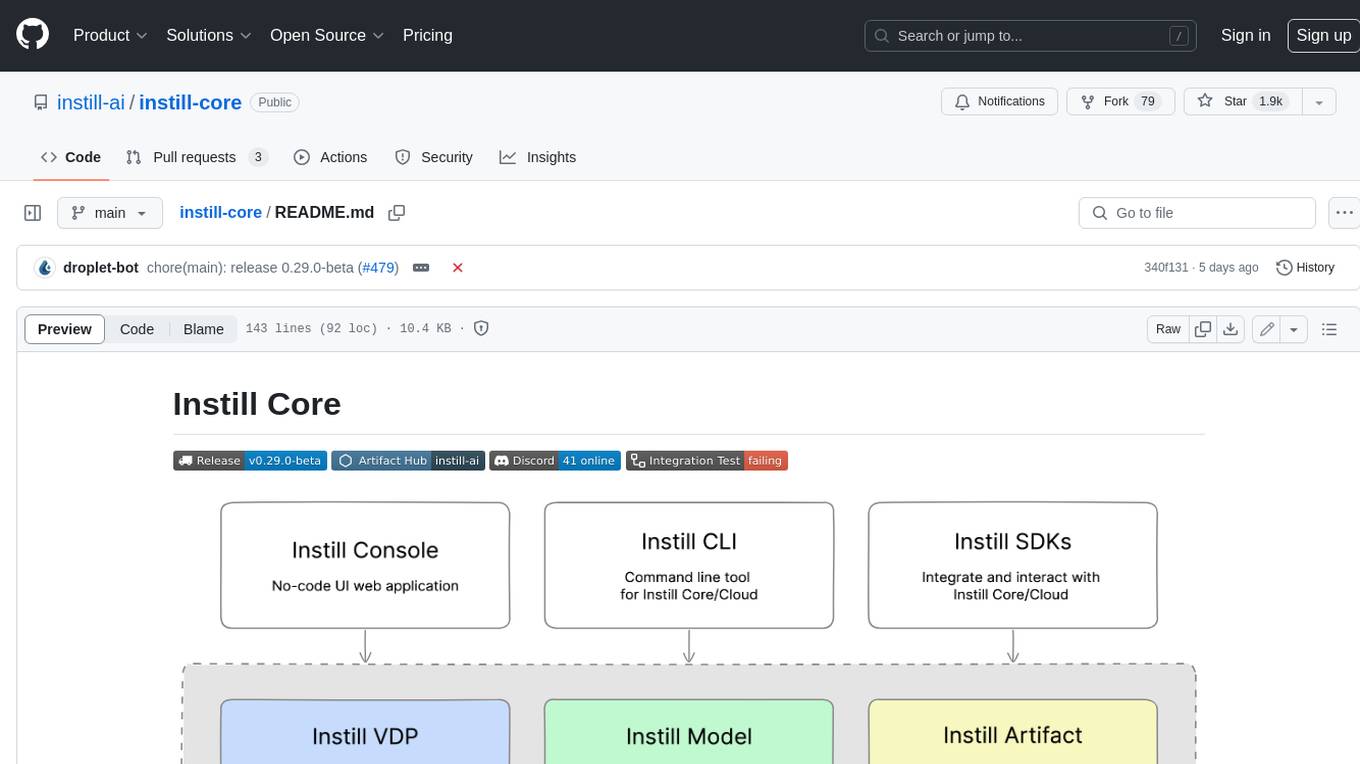
instill-core
Instill Core is an open-source orchestrator comprising a collection of source-available projects designed to streamline every aspect of building versatile AI features with unstructured data. It includes Instill VDP (Versatile Data Pipeline) for unstructured data, AI, and pipeline orchestration, Instill Model for scalable MLOps and LLMOps for open-source or custom AI models, and Instill Artifact for unified unstructured data management. Instill Core can be used for tasks such as building, testing, and sharing pipelines, importing, serving, fine-tuning, and monitoring ML models, and transforming documents, images, audio, and video into a unified AI-ready format.
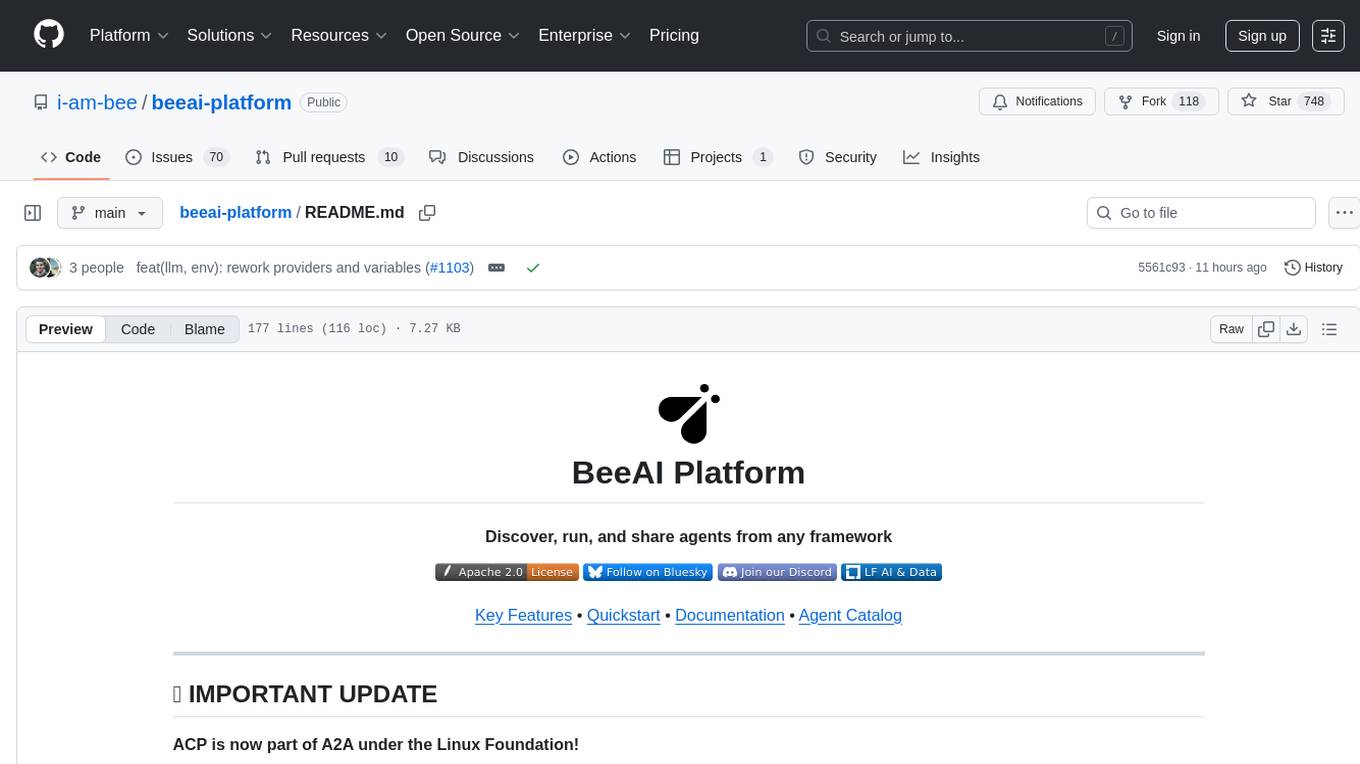
beeai-platform
BeeAI is an open-source platform that simplifies the discovery, running, and sharing of AI agents across different frameworks. It addresses challenges such as framework fragmentation, deployment complexity, and discovery issues by providing a standardized platform for individuals and teams to access agents easily. With features like a centralized agent catalog, framework-agnostic interfaces, containerized agents, and consistent user experiences, BeeAI aims to streamline the process of working with AI agents for both developers and teams.
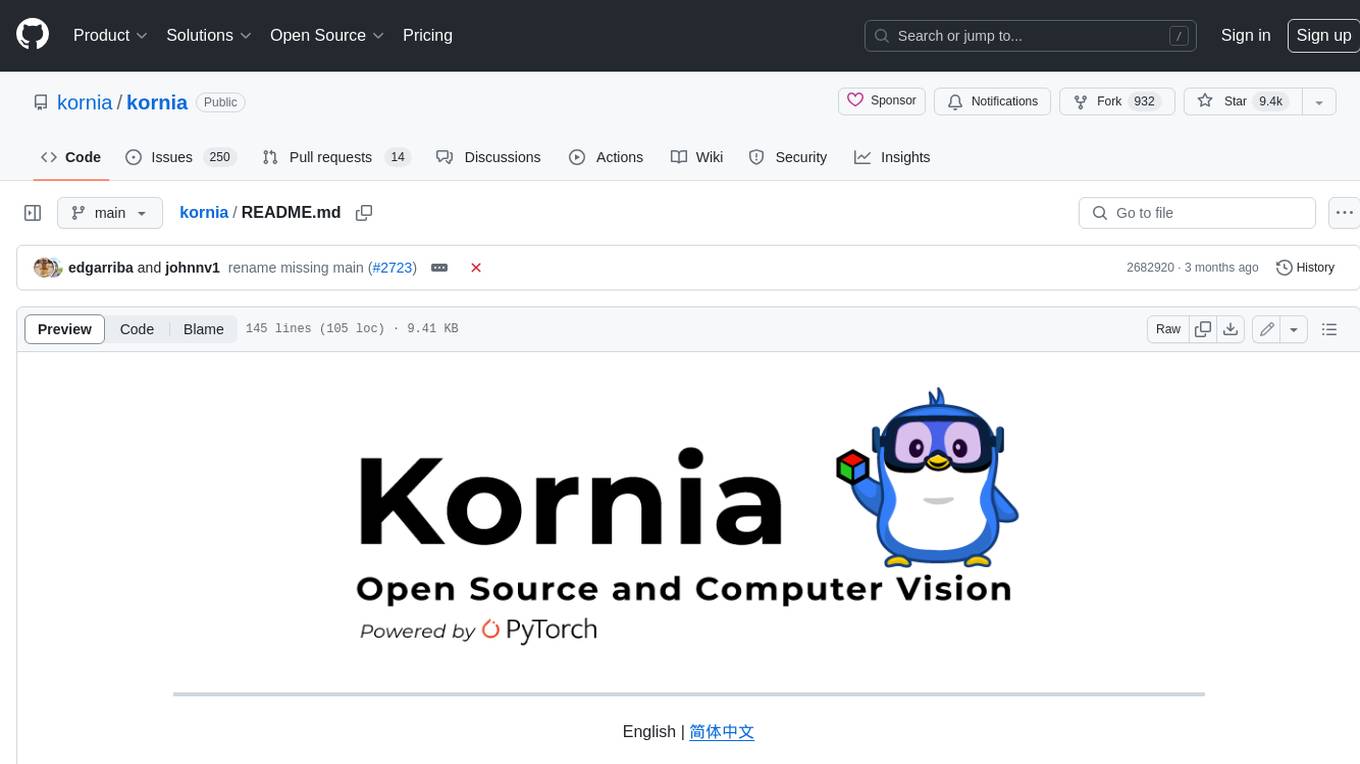
kornia
Kornia is a differentiable computer vision library for PyTorch. It consists of a set of routines and differentiable modules to solve generic computer vision problems. At its core, the package uses PyTorch as its main backend both for efficiency and to take advantage of the reverse-mode auto-differentiation to define and compute the gradient of complex functions.
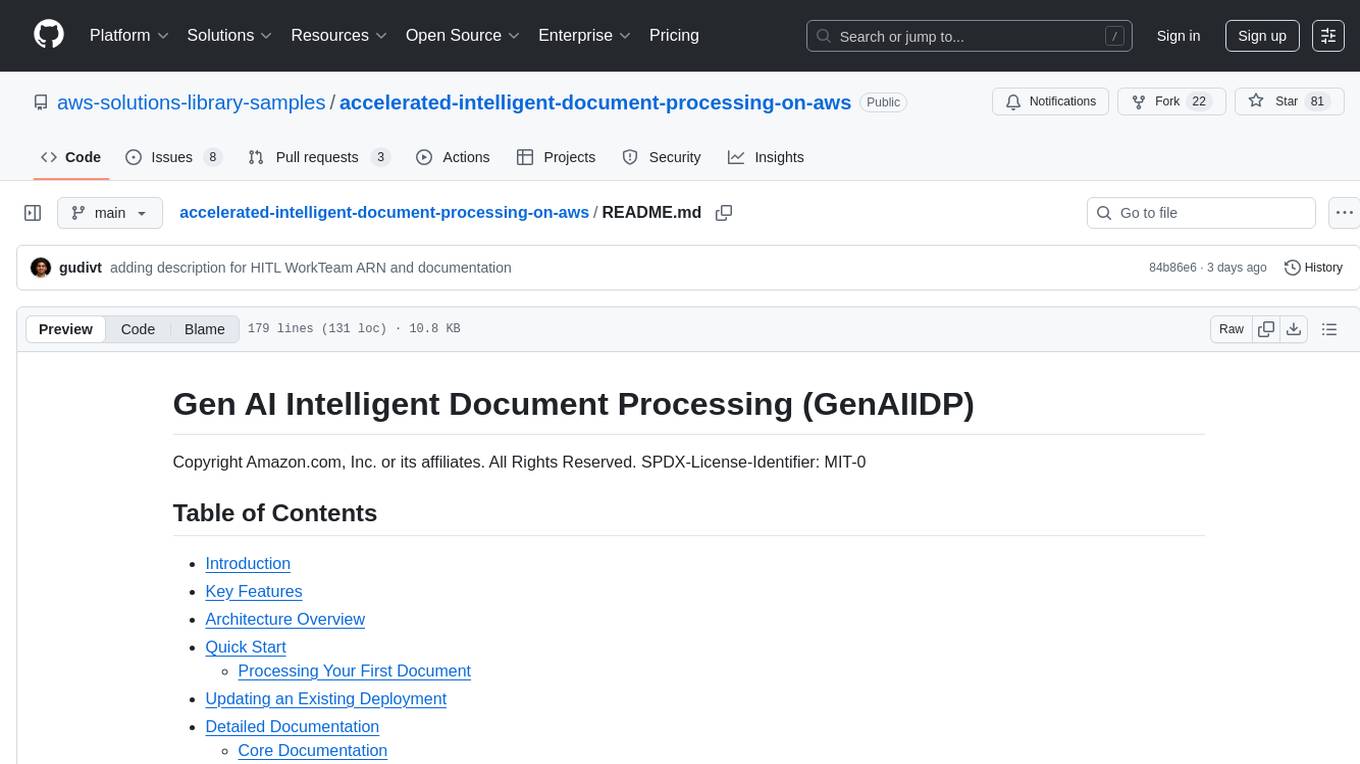
accelerated-intelligent-document-processing-on-aws
Accelerated Intelligent Document Processing on AWS is a scalable, serverless solution for automated document processing and information extraction using AWS services. It combines OCR capabilities with generative AI to convert unstructured documents into structured data at scale. The solution features a serverless architecture built on AWS technologies, modular processing patterns, advanced classification support, few-shot example support, custom business logic integration, high throughput processing, built-in resilience, cost optimization, comprehensive monitoring, web user interface, human-in-the-loop integration, AI-powered evaluation, extraction confidence assessment, and document knowledge base query. The architecture uses nested CloudFormation stacks to support multiple document processing patterns while maintaining common infrastructure for queueing, tracking, and monitoring.
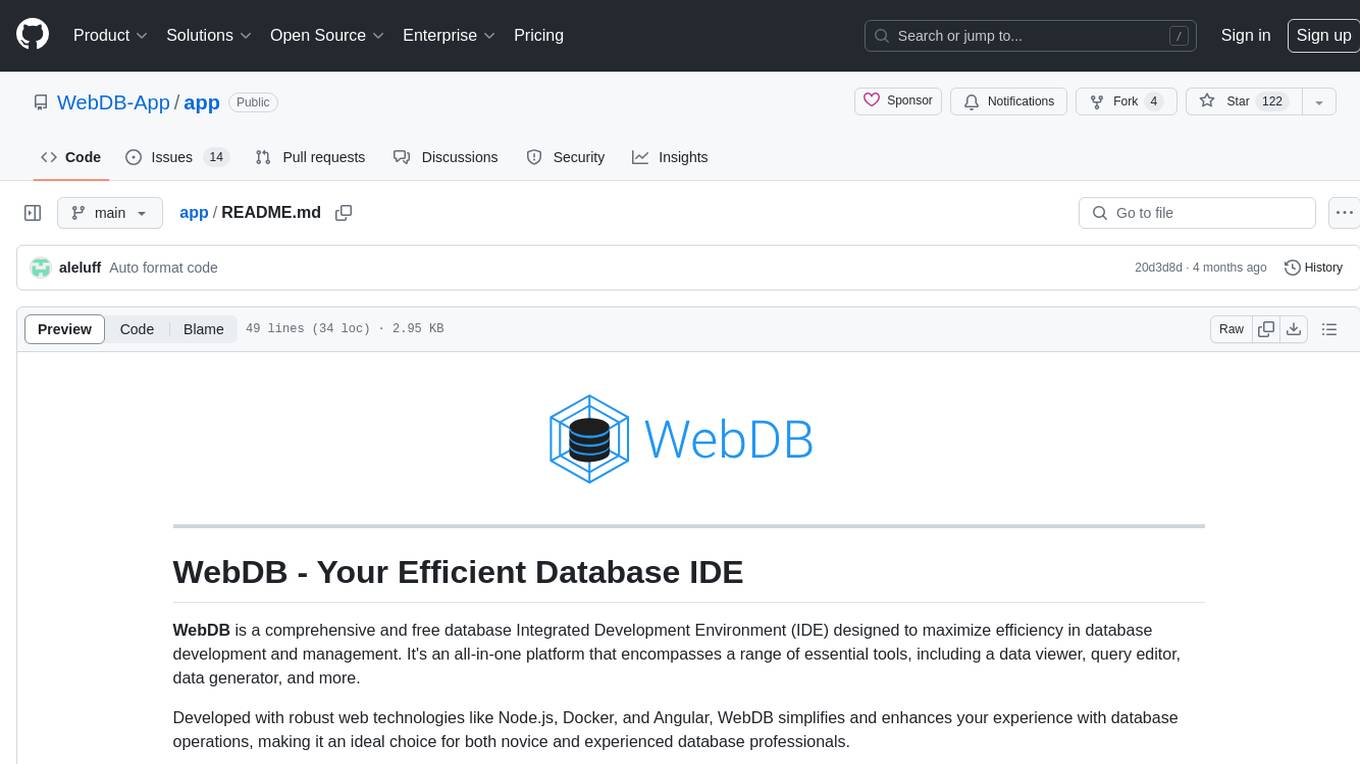
app
WebDB is a comprehensive and free database Integrated Development Environment (IDE) designed to maximize efficiency in database development and management. It simplifies and enhances database operations with features like DBMS discovery, query editor, time machine, NoSQL structure inferring, modern ERD visualization, and intelligent data generator. Developed with robust web technologies, WebDB is suitable for both novice and experienced database professionals.
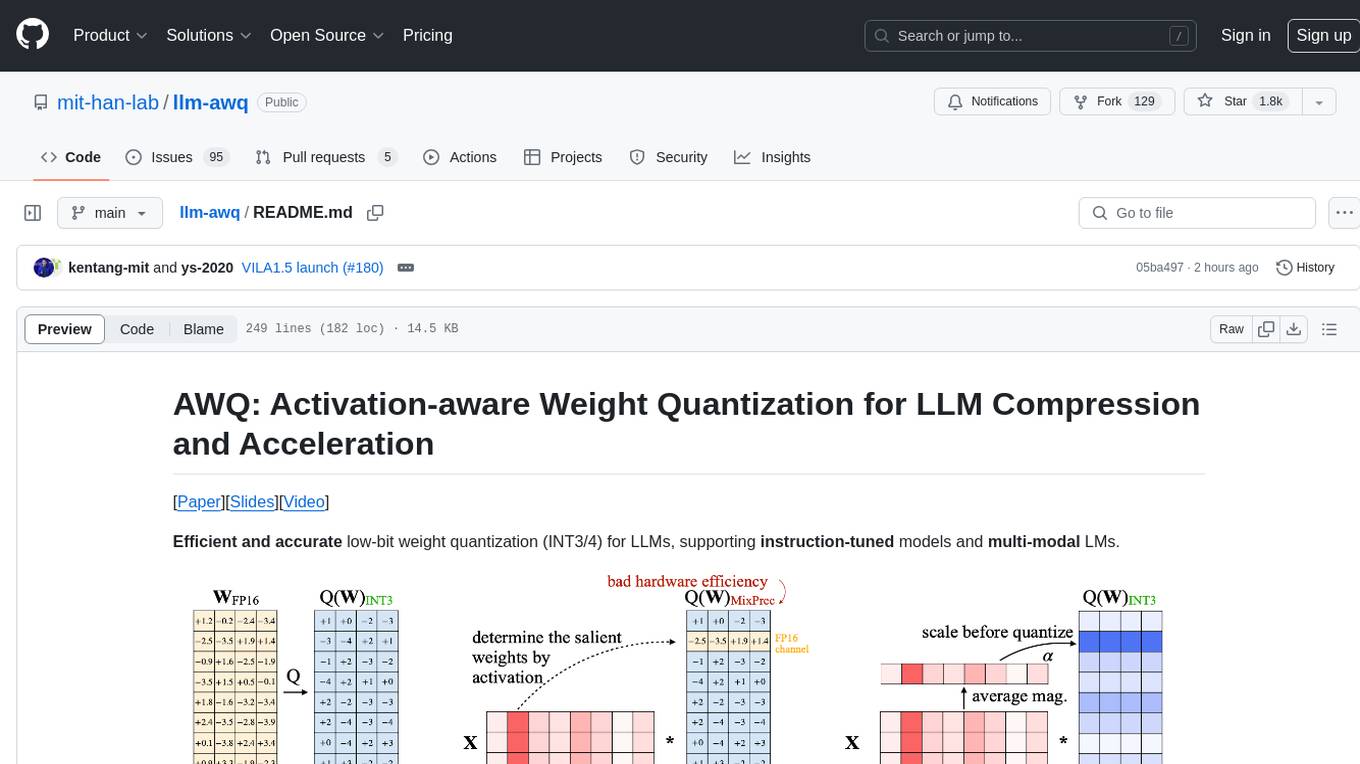
llm-awq
AWQ (Activation-aware Weight Quantization) is a tool designed for efficient and accurate low-bit weight quantization (INT3/4) for Large Language Models (LLMs). It supports instruction-tuned models and multi-modal LMs, providing features such as AWQ search for accurate quantization, pre-computed AWQ model zoo for various LLMs, memory-efficient 4-bit linear in PyTorch, and efficient CUDA kernel implementation for fast inference. The tool enables users to run large models on resource-constrained edge platforms, delivering more efficient responses with LLM/VLM chatbots through 4-bit inference.
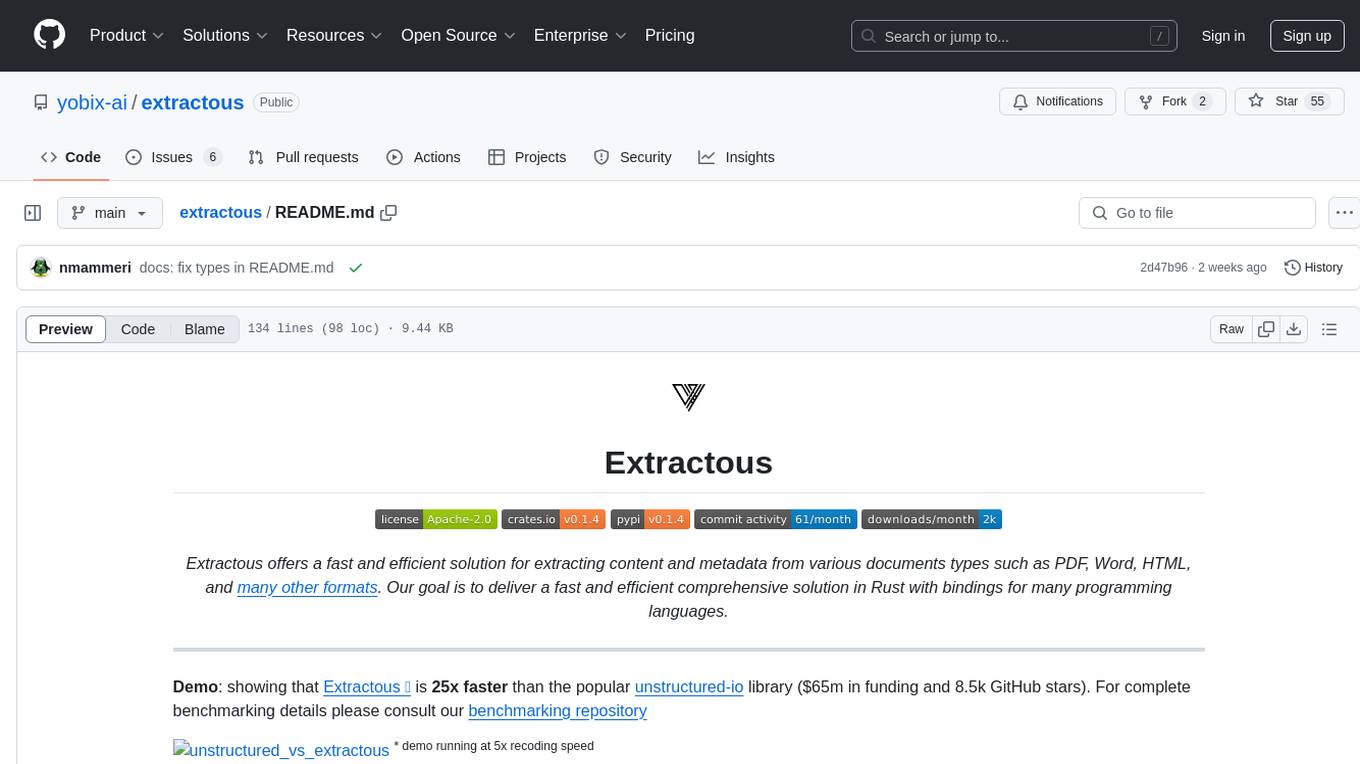
extractous
Extractous offers a fast and efficient solution for extracting content and metadata from various document types such as PDF, Word, HTML, and many other formats. It is built with Rust, providing high performance, memory safety, and multi-threading capabilities. The tool eliminates the need for external services or APIs, making data processing pipelines faster and more efficient. It supports multiple file formats, including Microsoft Office, OpenOffice, PDF, spreadsheets, web documents, e-books, text files, images, and email formats. Extractous provides a clear and simple API for extracting text and metadata content, with upcoming support for JavaScript/TypeScript. It is free for commercial use under the Apache 2.0 License.
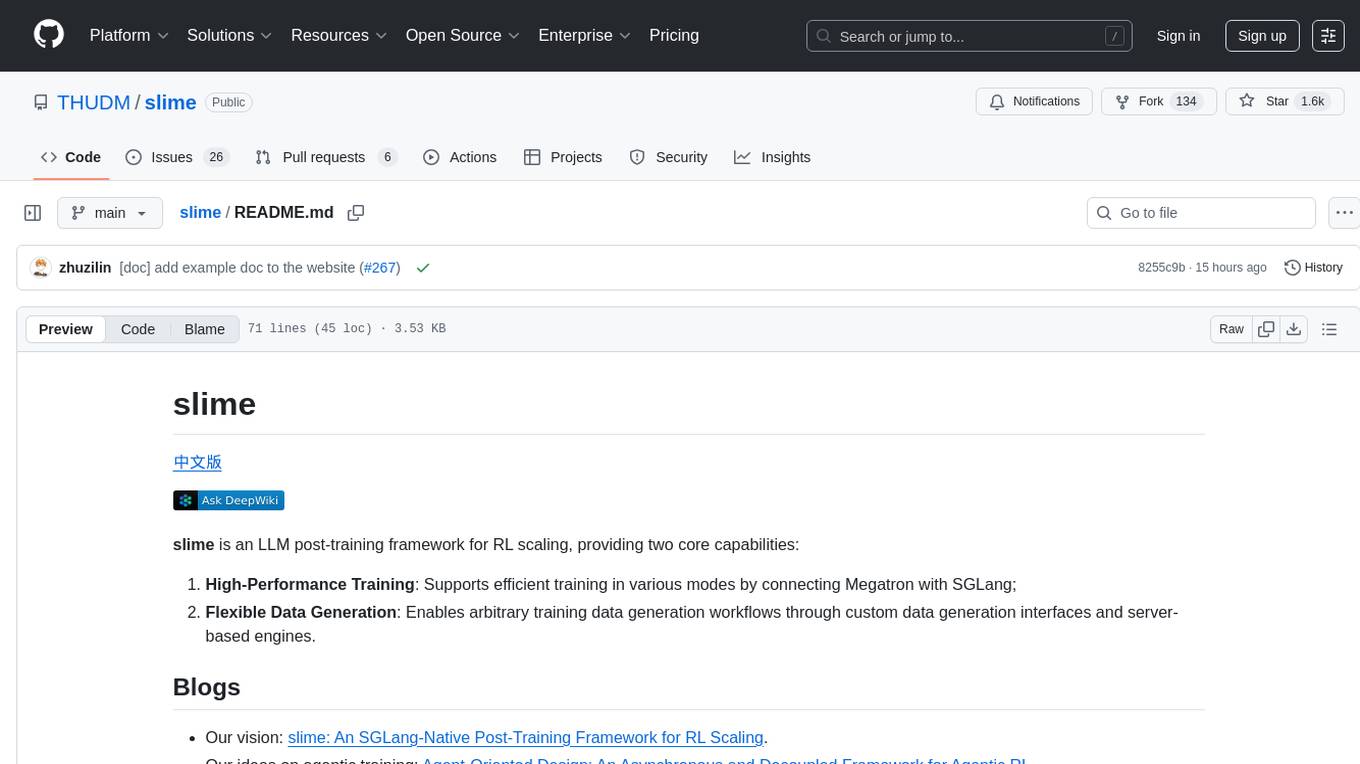
slime
Slime is an LLM post-training framework for RL scaling that provides high-performance training and flexible data generation capabilities. It connects Megatron with SGLang for efficient training and enables custom data generation workflows through server-based engines. The framework includes modules for training, rollout, and data buffer management, offering a comprehensive solution for RL scaling.
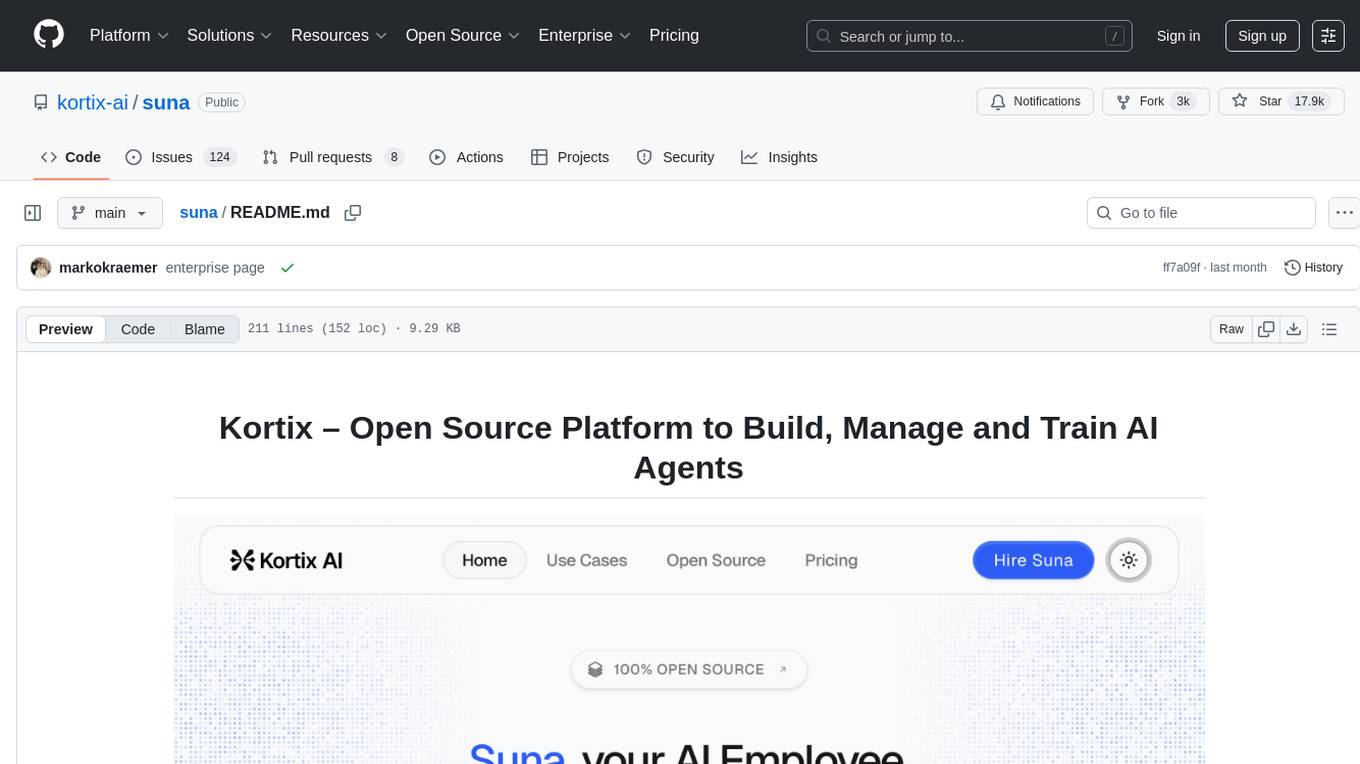
suna
Kortix is an open-source platform designed to build, manage, and train AI agents for various tasks. It allows users to create autonomous agents, from general-purpose assistants to specialized automation tools. The platform offers capabilities such as browser automation, file management, web intelligence, system operations, API integrations, and agent building tools. Users can create custom agents tailored to specific domains, workflows, or business needs, enabling tasks like research & analysis, browser automation, file & document management, data processing & analysis, and system administration.
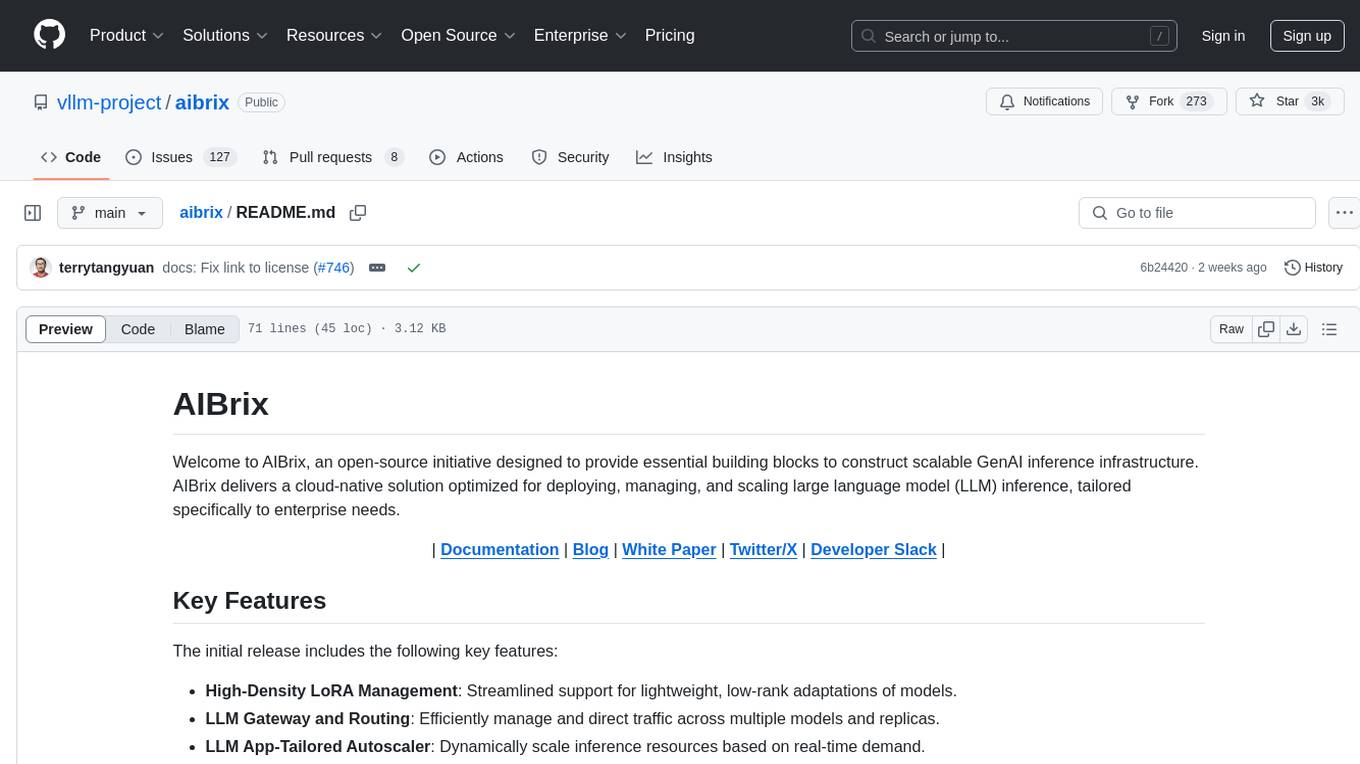
aibrix
AIBrix is an open-source initiative providing essential building blocks for scalable GenAI inference infrastructure. It delivers a cloud-native solution optimized for deploying, managing, and scaling large language model (LLM) inference, tailored to enterprise needs. Key features include High-Density LoRA Management, LLM Gateway and Routing, LLM App-Tailored Autoscaler, Unified AI Runtime, Distributed Inference, Distributed KV Cache, Cost-efficient Heterogeneous Serving, and GPU Hardware Failure Detection.
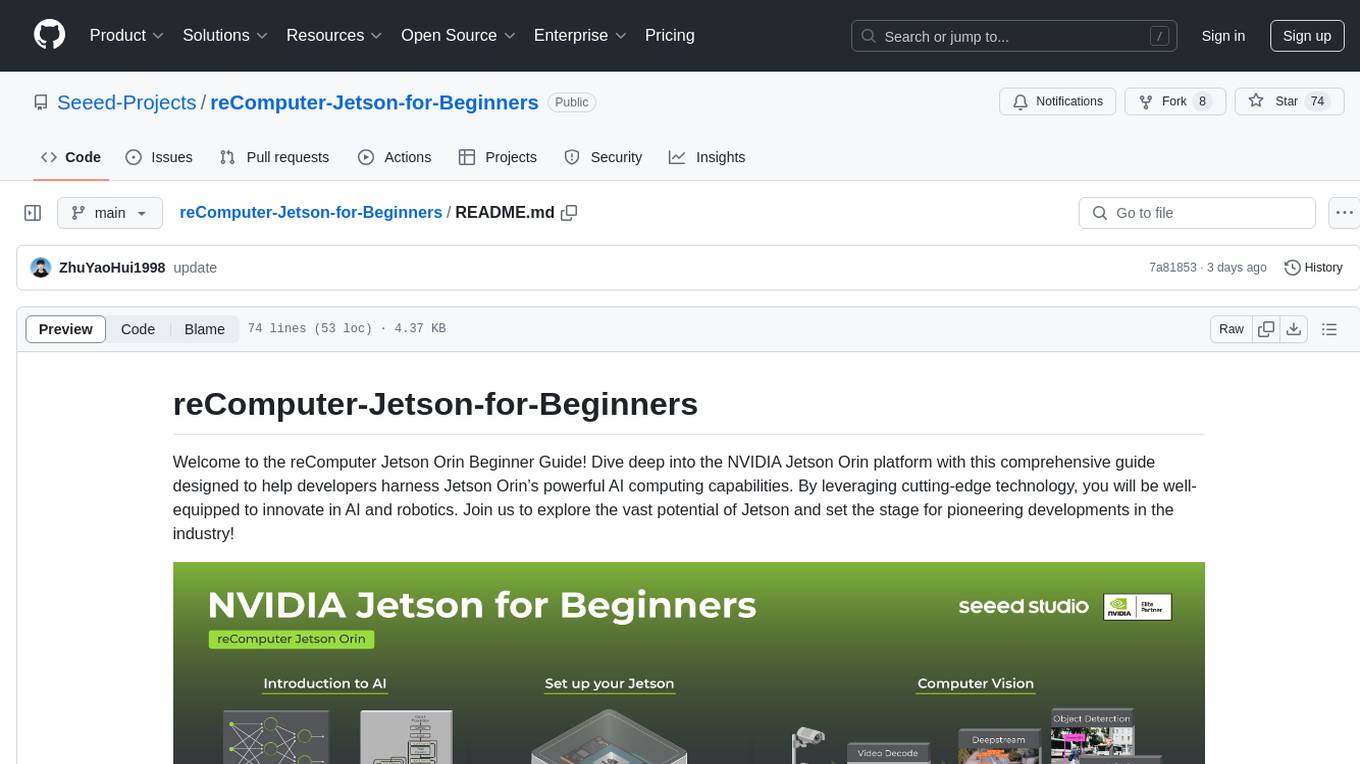
reComputer-Jetson-for-Beginners
The reComputer Jetson Orin Beginner Guide is a comprehensive resource designed to help developers explore and harness the powerful AI computing capabilities of the NVIDIA Jetson Orin platform. The guide covers a wide range of topics, from basic tools and getting started to advanced applications in computer vision, generative AI, robotics, and more. With step-by-step tutorials and hands-on projects, users can learn to master NVIDIA's core technologies and popular AI frameworks, enabling them to innovate in AI and robotics. The guide is suitable for beginners looking to dive into AI development and build cutting-edge projects with Jetson Orin.
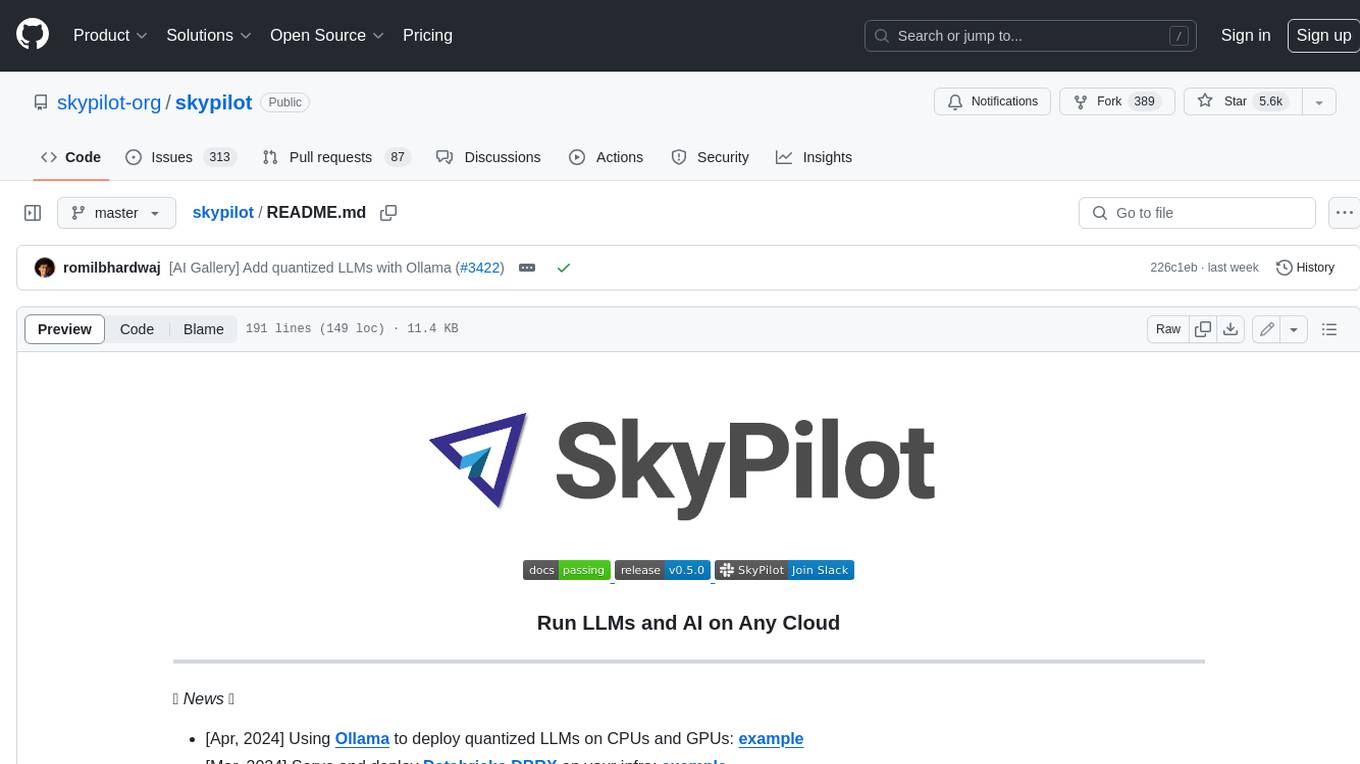
skypilot
SkyPilot is a framework for running LLMs, AI, and batch jobs on any cloud, offering maximum cost savings, highest GPU availability, and managed execution. SkyPilot abstracts away cloud infra burdens: - Launch jobs & clusters on any cloud - Easy scale-out: queue and run many jobs, automatically managed - Easy access to object stores (S3, GCS, R2) SkyPilot maximizes GPU availability for your jobs: * Provision in all zones/regions/clouds you have access to (the _Sky_), with automatic failover SkyPilot cuts your cloud costs: * Managed Spot: 3-6x cost savings using spot VMs, with auto-recovery from preemptions * Optimizer: 2x cost savings by auto-picking the cheapest VM/zone/region/cloud * Autostop: hands-free cleanup of idle clusters SkyPilot supports your existing GPU, TPU, and CPU workloads, with no code changes.
For similar tasks

wanwu
Wanwu AI Agent Platform is an enterprise-grade one-stop commercially friendly AI agent development platform designed for business scenarios. It provides enterprises with a safe, efficient, and compliant one-stop AI solution. The platform integrates cutting-edge technologies such as large language models and business process automation to build an AI engineering platform covering model full life-cycle management, MCP, web search, AI agent rapid development, enterprise knowledge base construction, and complex workflow orchestration. It supports modular architecture design, flexible functional expansion, and secondary development, reducing the application threshold of AI technology while ensuring security and privacy protection of enterprise data. It accelerates digital transformation, cost reduction, efficiency improvement, and business innovation for enterprises of all sizes.
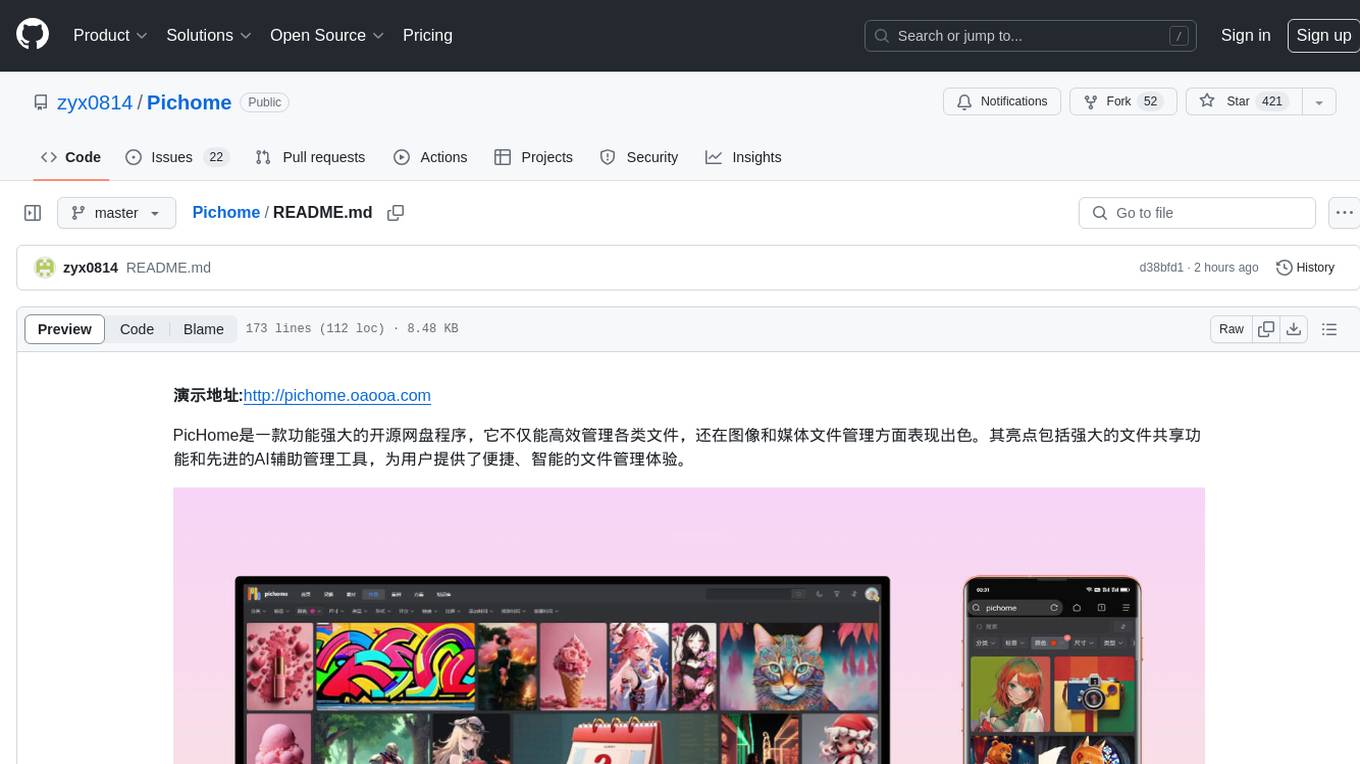
Pichome
PicHome is a powerful open-source cloud storage program that efficiently manages various types of files and excels in image and media file management. Its highlights include robust file sharing features and advanced AI-assisted management tools, providing users with a convenient and intelligent file management experience. The program offers diverse list modes, customizable file information display, enhanced quick file preview, advanced tagging, custom cover and preview images, multiple preview images, and multi-library management. Additionally, PicHome features strong file sharing capabilities, allowing users to share entire libraries, create personalized showcase web pages, and build complete data sharing websites. The AI-assisted management aspect includes AI file renaming, tagging, description writing, batch annotation, and file Q&A services, all aimed at improving file management efficiency. PicHome supports a wide range of file formats and can be applied in various scenarios such as e-commerce, gaming, design, development, enterprises, schools, labs, media, and entertainment institutions.
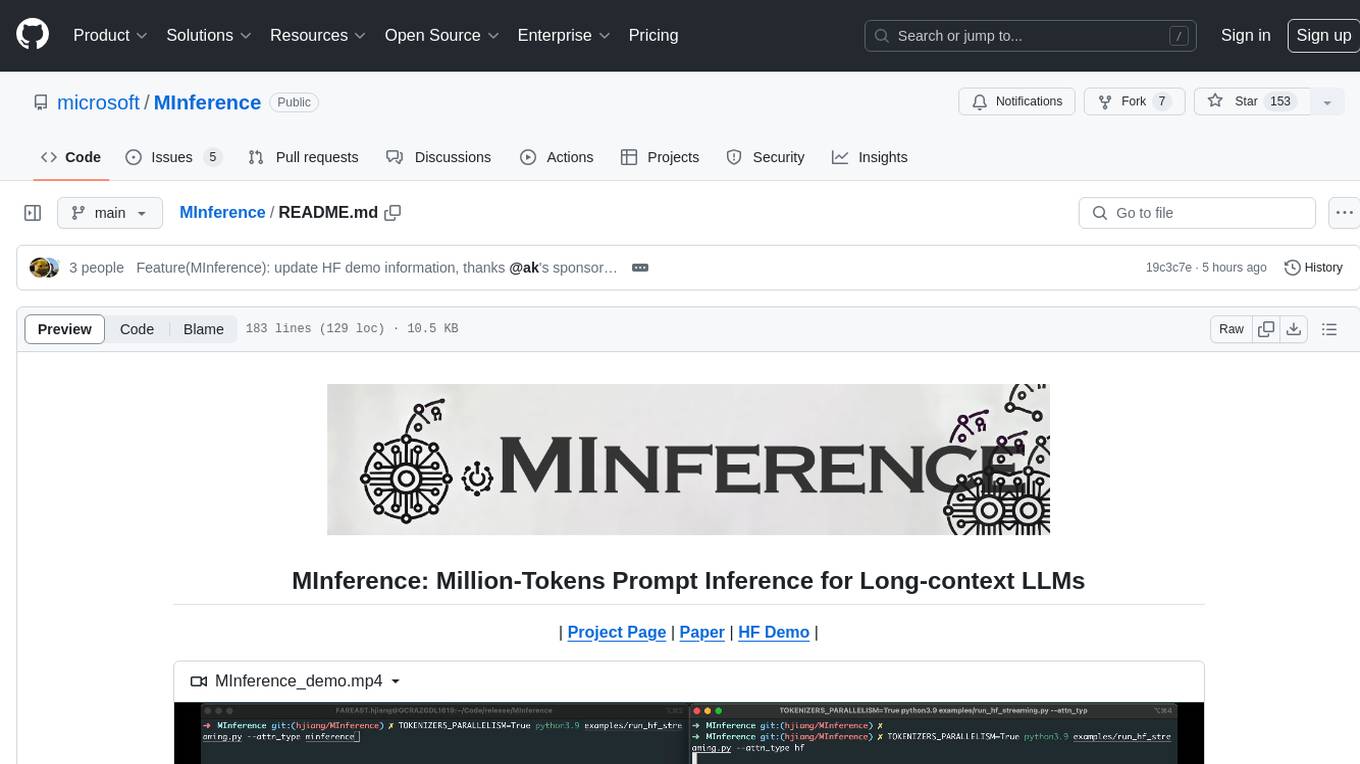
MInference
MInference is a tool designed to accelerate pre-filling for long-context Language Models (LLMs) by leveraging dynamic sparse attention. It achieves up to a 10x speedup for pre-filling on an A100 while maintaining accuracy. The tool supports various decoding LLMs, including LLaMA-style models and Phi models, and provides custom kernels for attention computation. MInference is useful for researchers and developers working with large-scale language models who aim to improve efficiency without compromising accuracy.
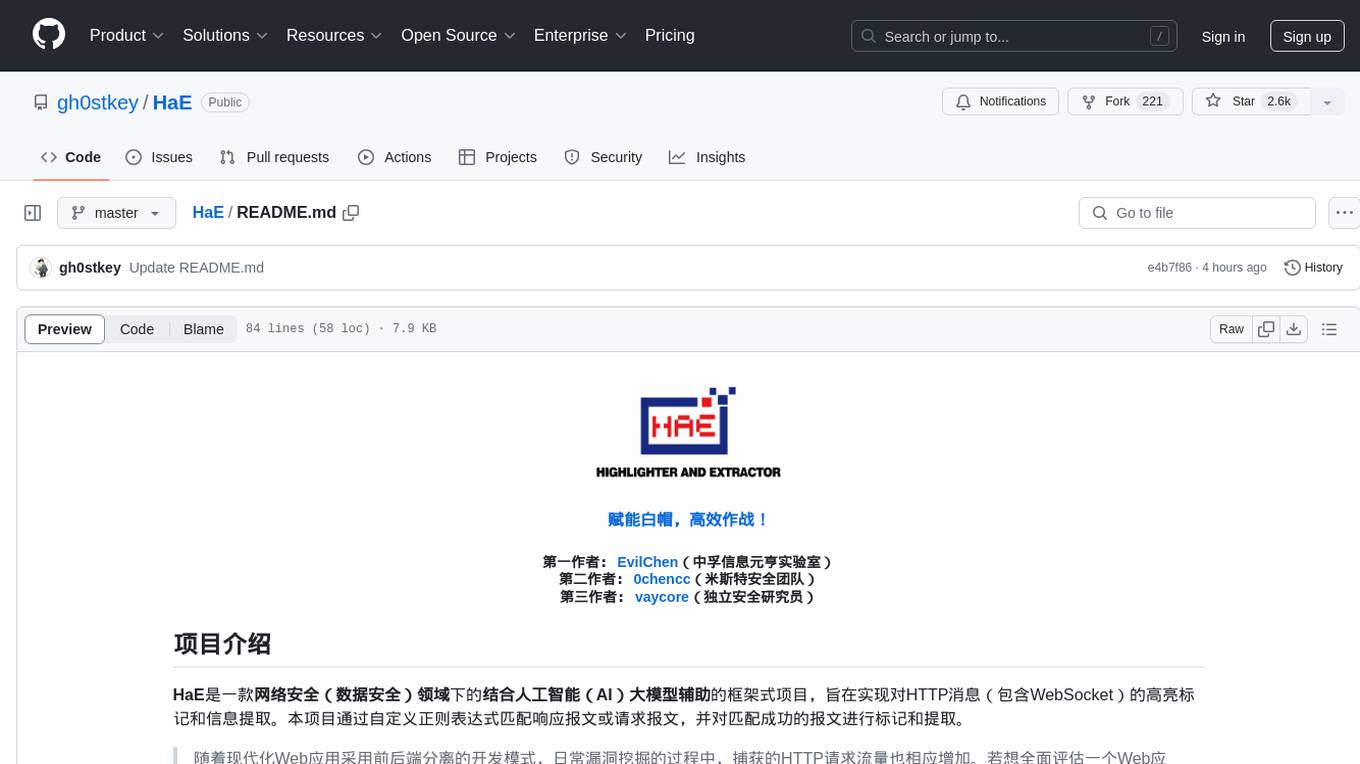
HaE
HaE is a framework project in the field of network security (data security) that combines artificial intelligence (AI) large models to achieve highlighting and information extraction of HTTP messages (including WebSocket). It aims to reduce testing time, focus on valuable and meaningful messages, and improve vulnerability discovery efficiency. The project provides a clear and visual interface design, simple interface interaction, and centralized data panel for querying and extracting information. It also features built-in color upgrade algorithm, one-click export/import of data, and integration of AI large models API for optimized data processing.
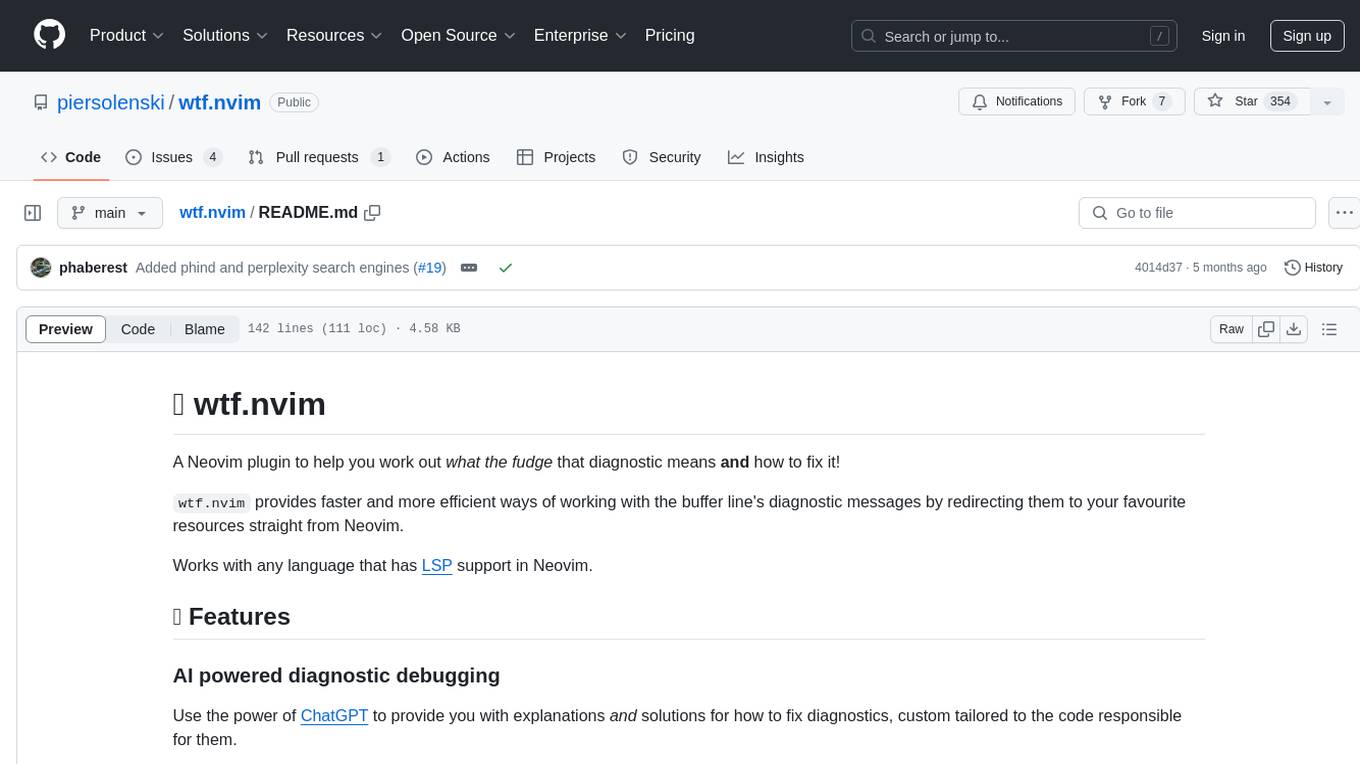
wtf.nvim
wtf.nvim is a Neovim plugin that enhances diagnostic debugging by providing explanations and solutions for code issues using ChatGPT. It allows users to search the web for answers directly from Neovim, making the debugging process faster and more efficient. The plugin works with any language that has LSP support in Neovim, offering AI-powered diagnostic assistance and seamless integration with various resources for resolving coding problems.
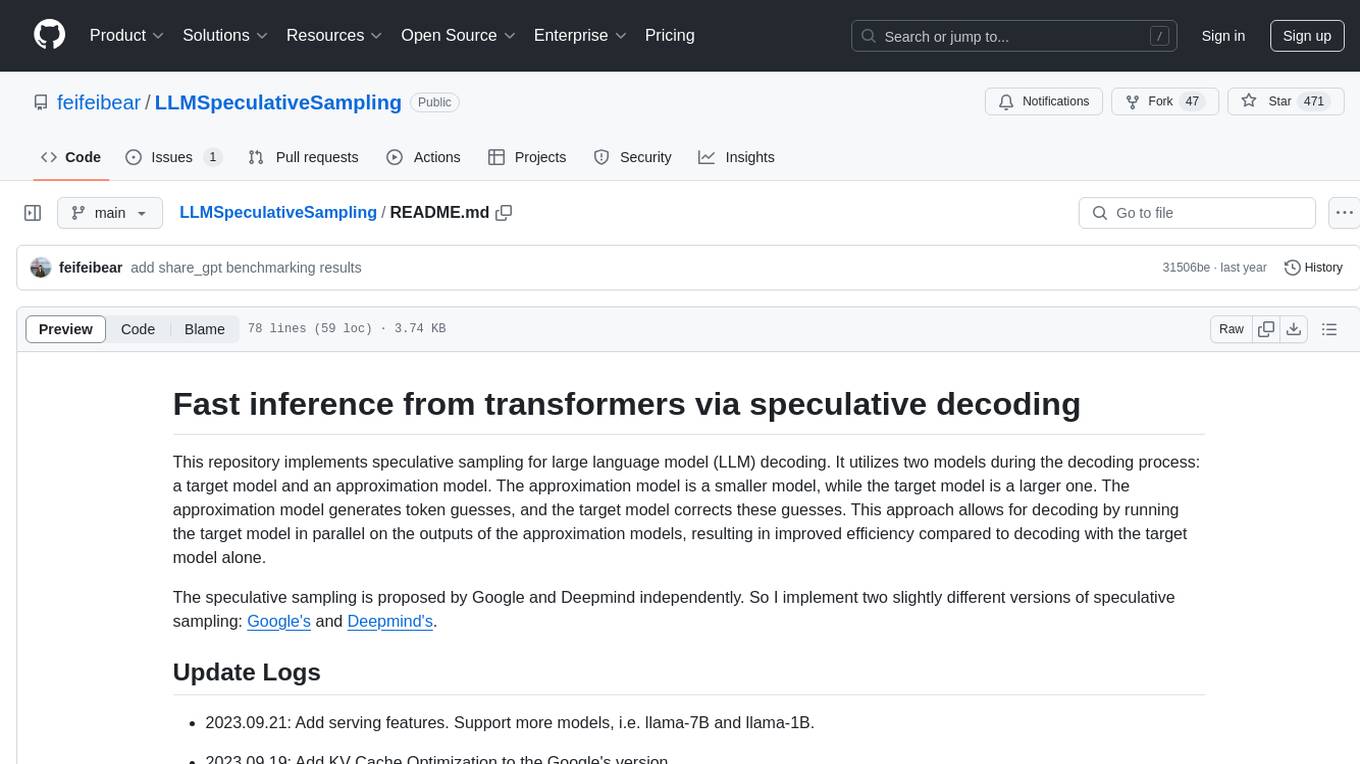
LLMSpeculativeSampling
This repository implements speculative sampling for large language model (LLM) decoding, utilizing two models - a target model and an approximation model. The approximation model generates token guesses, corrected by the target model, resulting in improved efficiency. It includes implementations of Google's and Deepmind's versions of speculative sampling, supporting models like llama-7B and llama-1B. The tool is designed for fast inference from transformers via speculative decoding.
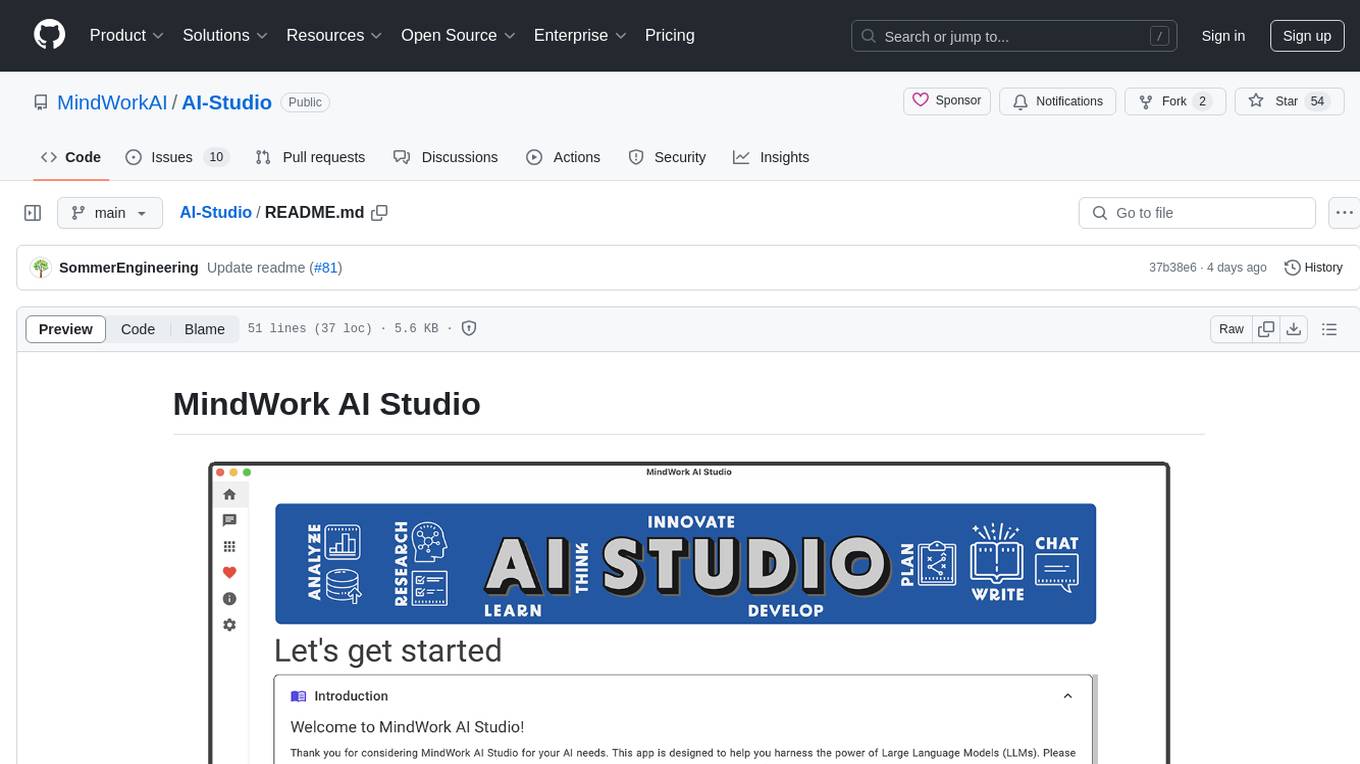
AI-Studio
MindWork AI Studio is a desktop application that provides a unified chat interface for Large Language Models (LLMs). It is free to use for personal and commercial purposes, offers independence in choosing LLM providers, provides unrestricted usage through the providers API, and is cost-effective with pay-as-you-go pricing. The app prioritizes privacy, flexibility, minimal storage and memory usage, and low impact on system resources. Users can support the project through monthly contributions or one-time donations, with opportunities for companies to sponsor the project for public relations and marketing benefits. Planned features include support for more LLM providers, system prompts integration, text replacement for privacy, and advanced interactions tailored for various use cases.
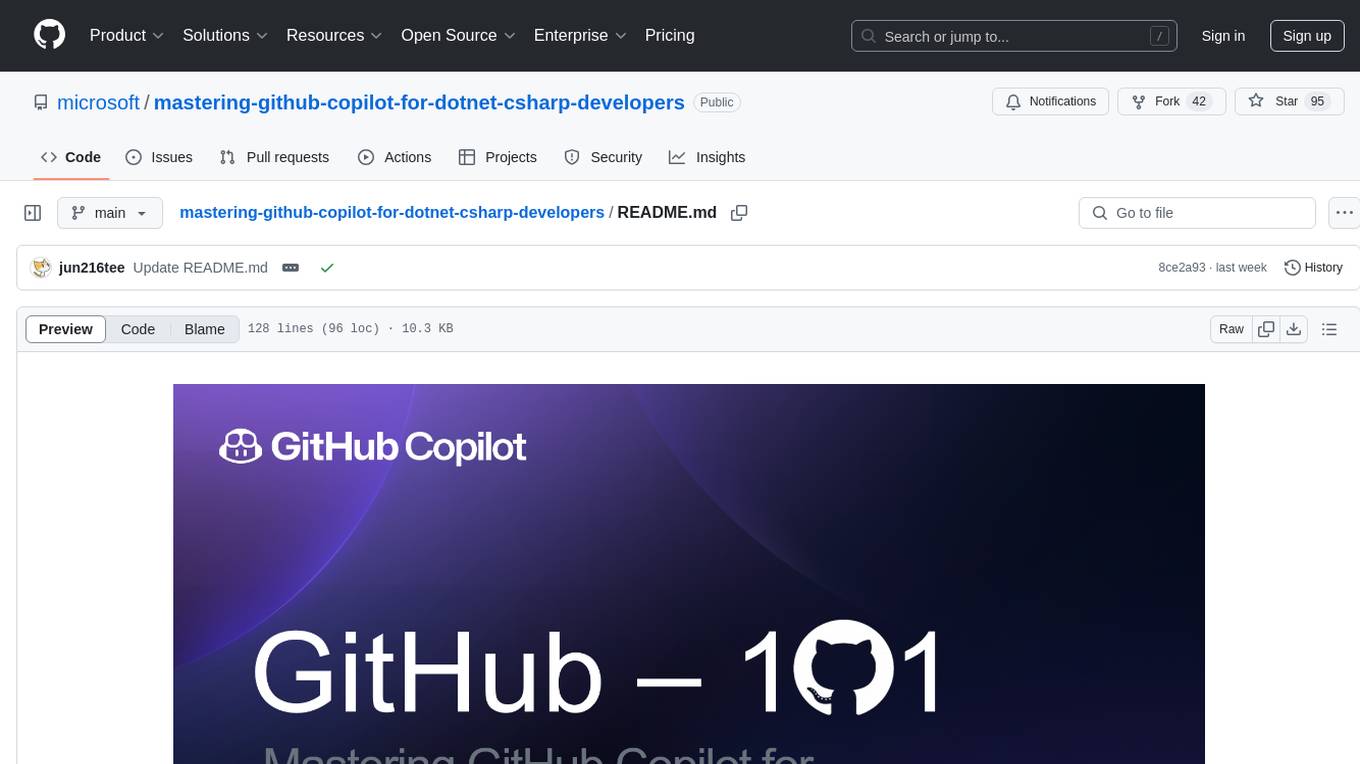
mastering-github-copilot-for-dotnet-csharp-developers
Enhance coding efficiency with expert-led GitHub Copilot course for C#/.NET developers. Learn to integrate AI-powered coding assistance, automate testing, and boost collaboration using Visual Studio Code and Copilot Chat. From autocompletion to unit testing, cover essential techniques for cleaner, faster, smarter code.
For similar jobs

sweep
Sweep is an AI junior developer that turns bugs and feature requests into code changes. It automatically handles developer experience improvements like adding type hints and improving test coverage.

teams-ai
The Teams AI Library is a software development kit (SDK) that helps developers create bots that can interact with Teams and Microsoft 365 applications. It is built on top of the Bot Framework SDK and simplifies the process of developing bots that interact with Teams' artificial intelligence capabilities. The SDK is available for JavaScript/TypeScript, .NET, and Python.

ai-guide
This guide is dedicated to Large Language Models (LLMs) that you can run on your home computer. It assumes your PC is a lower-end, non-gaming setup.

classifai
Supercharge WordPress Content Workflows and Engagement with Artificial Intelligence. Tap into leading cloud-based services like OpenAI, Microsoft Azure AI, Google Gemini and IBM Watson to augment your WordPress-powered websites. Publish content faster while improving SEO performance and increasing audience engagement. ClassifAI integrates Artificial Intelligence and Machine Learning technologies to lighten your workload and eliminate tedious tasks, giving you more time to create original content that matters.

chatbot-ui
Chatbot UI is an open-source AI chat app that allows users to create and deploy their own AI chatbots. It is easy to use and can be customized to fit any need. Chatbot UI is perfect for businesses, developers, and anyone who wants to create a chatbot.

BricksLLM
BricksLLM is a cloud native AI gateway written in Go. Currently, it provides native support for OpenAI, Anthropic, Azure OpenAI and vLLM. BricksLLM aims to provide enterprise level infrastructure that can power any LLM production use cases. Here are some use cases for BricksLLM: * Set LLM usage limits for users on different pricing tiers * Track LLM usage on a per user and per organization basis * Block or redact requests containing PIIs * Improve LLM reliability with failovers, retries and caching * Distribute API keys with rate limits and cost limits for internal development/production use cases * Distribute API keys with rate limits and cost limits for students

uAgents
uAgents is a Python library developed by Fetch.ai that allows for the creation of autonomous AI agents. These agents can perform various tasks on a schedule or take action on various events. uAgents are easy to create and manage, and they are connected to a fast-growing network of other uAgents. They are also secure, with cryptographically secured messages and wallets.

griptape
Griptape is a modular Python framework for building AI-powered applications that securely connect to your enterprise data and APIs. It offers developers the ability to maintain control and flexibility at every step. Griptape's core components include Structures (Agents, Pipelines, and Workflows), Tasks, Tools, Memory (Conversation Memory, Task Memory, and Meta Memory), Drivers (Prompt and Embedding Drivers, Vector Store Drivers, Image Generation Drivers, Image Query Drivers, SQL Drivers, Web Scraper Drivers, and Conversation Memory Drivers), Engines (Query Engines, Extraction Engines, Summary Engines, Image Generation Engines, and Image Query Engines), and additional components (Rulesets, Loaders, Artifacts, Chunkers, and Tokenizers). Griptape enables developers to create AI-powered applications with ease and efficiency.


